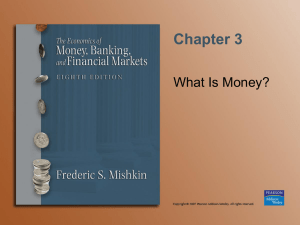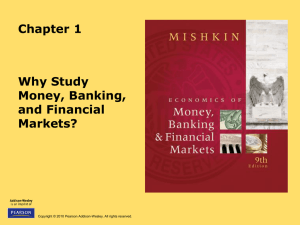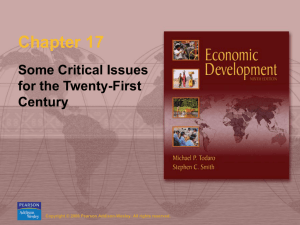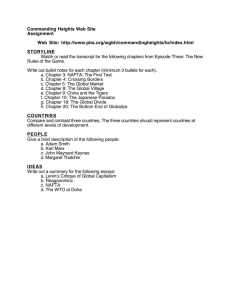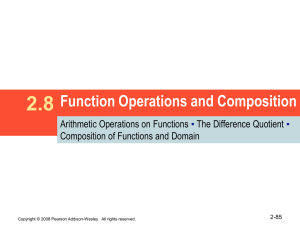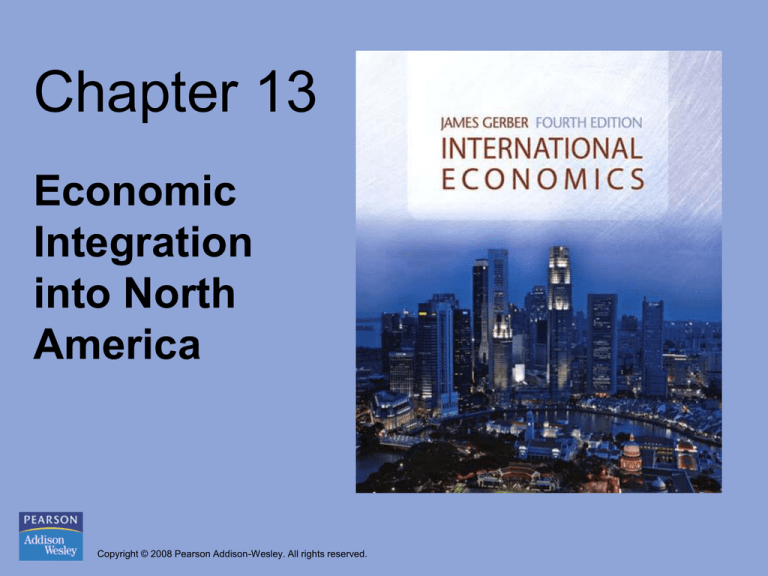
Chapter 13
Economic
Integration
into North
America
Copyright © 2008 Pearson Addison-Wesley. All rights reserved.
Chapter Objectives
• Explore the formation and impact of the CanadianUnited States Trade Agreement (CUSTA), the North
American Free Trade Agreement (NAFTA), and the
Dominican Republic-Central American Free Trade
Agreement (DR-CAFTA)
• Understand the sources of political controversy
surrounding NAFTA’s negotiations and ratification
Copyright © 2008 Pearson Addison-Wesley. All rights reserved.
13-2
TABLE 13.1 Population and GDP for
Canada, Mexico, and the United States,
2005
Copyright © 2008 Pearson Addison-Wesley. All rights reserved.
13-3
The North American Market in
Sum
• Enormous market: larger than the EU
• Vast income differences between Mexico on the one
hand, and the U.S. and Canada, on the other
– However, purchasing power parity gap is smaller
– On average, the North American market is very rich
• The North American market is marked by numerous
difficult policy questions on migration and
environmental and labor standards, for example
Copyright © 2008 Pearson Addison-Wesley. All rights reserved.
13-4
TABLE 13.2 Trade within the NAFTA
Region, 2005 (Millions of U.S. dollars)
Copyright © 2008 Pearson Addison-Wesley. All rights reserved.
13-5
FIGURE 13.1 Canada–United States
Merchandise Trade, 1989–2005
Copyright © 2008 Pearson Addison-Wesley. All rights reserved.
13-6
The Canadian–U.S. Trade
Agreement (CUSTA) of 1989
• Helped Canada overcome growing U.S. protectionism
and Asian competitiveness
– However, many Canadians feared competition by U.S. firms,
erosion of Canada’s social programs, and U.S. cultural
influence
• Rather modest impact
– In 1989–1994, U.S. exports to Canada grew by 46.6%, and
Canadian exports to the U.S. by 55%
– Canadian fears were largely unfounded
Copyright © 2008 Pearson Addison-Wesley. All rights reserved.
13-7
Mexico’s Economic History
• Between the end of World War II and 1980s, Mexico
followed inward-oriented import substitution
industrialization (ISI) policies—industrial policies
targeting the development of manufacturing sectors that
can compete against imported goods
– ISI succeeded in stimulating GDP growth and a shift toward
industrialization
– However, ISI created serious problems: reduced export
capacity and created conditions for corruption
Copyright © 2008 Pearson Addison-Wesley. All rights reserved.
13-8
Mexico’s Economic Turnaround
• In the late-1970s, Mexico was prospering thanks to
high revenues from oil production
• However, problems emerged in 1981
– World oil prices declined, reducing Mexico´s credit
worthiness
– Dramatic rise in U.S. interest rates increased the interest
charged on Mexico’s debt with commercial banks
• In August 1982, the debt crisis began: Mexico suspend
payments of the principal of its debts
Copyright © 2008 Pearson Addison-Wesley. All rights reserved.
13-9
The 1980s: The Lost Decade
• 1980s was the lost decade in Latin America:
GDP growth was nonexistent, foreign capital
stopped flowing in, credit became scarce,
investment declined
• The economic crisis stemmed from
macroeconomic mismanagement: large
government expenditures had increased
borrowing and indebtedness
Copyright © 2008 Pearson Addison-Wesley. All rights reserved.
13-10
Resolving the Debt Crisis
• Mexico agreed on budget cuts and peso
devaluation in return to restructuring the debt
repayments with U.S. government, banks, and
the IMF
• Budget cuts and inflation had a social cost: real
wages fell by 40–50% in 1983–1988
Copyright © 2008 Pearson Addison-Wesley. All rights reserved.
13-11
Resolving Economic Problems
• In 1982, Mexico also set out to attack the deep-seated
structural problems of the economy
– Inflation was curbed
– Import restrictions and trade barriers were reduced: average
tariffs declined from 27% to 13.1% between 1982 and 1992
– The role of the state in the economy was reduced: stateowned companies were privatized
• Structural reforms revived growth and attracted foreign
investment
Copyright © 2008 Pearson Addison-Wesley. All rights reserved.
13-12
The North American Free Trade
Agreement (NAFTA) of 1994
• Tariffs on about half of goods traded between U.S. and
Mexico were eliminated immediately
– Most dramatic changes in Mexico: average tariffs on U.S.
goods fell from 10% to 2.9% between 1993 and 1996, while
U.S. tariffs on Mexican goods fell from 2.07% to 0.65%
• NAFTA specified content requirements for goods
subject to free trade
• NAFTA established a system of trade dispute resolution
Copyright © 2008 Pearson Addison-Wesley. All rights reserved.
13-13
The NAFTA Debate in the U.S.:
Labor and Environment
• NAFTA reignited contention on trade policy in the U.S.
– Blue collar labor unions feared that jobs would migrate to
south given Mexico’s lower labor costs
– Environmental groups feared that (1) polluting U.S. and
Canadian firms would move to Mexico, and (2) pollution
would increase along U.S.-Mexico border
• Political opposition forced Canada, Mexico, and the
U.S. to attach labor and environmental side agreements
to NAFTA
Copyright © 2008 Pearson Addison-Wesley. All rights reserved.
13-14
The NAFTA Debate in the U.S.:
Immigration
• Illegal immigration is a contentious issue in
U.S.-Mexico relations
– Proponents argue illegal immigrants support the U.S.
economy buy buying goods and services and help
keep prices low by increasing labor supply
– Opponents argue the U.S. should not ignore illegal
behavior and that the increased labor from illegal
immigration suppresses wages for legal workers
Copyright © 2008 Pearson Addison-Wesley. All rights reserved.
13-15
The NAFTA Debate in the U.S.:
Border Enforcement
• Attempts at stricter border enforcement have
been largely unsuccessful at stopping illegal
immigration
– The border is too long – 2,000 miles
– The economic incentive the enter the U.S. is too high
– Nearly half of the illegal immigrants entered legal,
but did not return home when their visa’s expired
Copyright © 2008 Pearson Addison-Wesley. All rights reserved.
13-16
The Impact of NAFTA on U.S.
Economy
• Local effects of NAFTA on trade and economy
are dramatic especially in the U.S.-Mexican
border
• However, Mexico’s economy is 5% of U.S.
economy: NAFTA has had a very modest impact
on overall U.S. trade balance and current
account or on jobs and wages
Copyright © 2008 Pearson Addison-Wesley. All rights reserved.
13-17
The Impact of NAFTA on U.S.Mexico Trade
• Trade flows between U.S. and Mexico have shot up
• The growth in trade between all three NAFTA partners
indicates increased specialization, economies of scale,
and efficiency
• However, the exact impact of NAFTA is hard to assess
– Bilateral trade has expanded already since 1989 thanks to
Mexico’s economic reforms
– Mexico’s 1994–1995 peso crisis and recession caused U.S.
exports to decline momentarily to Mexico
Copyright © 2008 Pearson Addison-Wesley. All rights reserved.
13-18
FIGURE 13.2 United States–Mexico
Merchandise Trade, 1989–2005
Copyright © 2008 Pearson Addison-Wesley. All rights reserved.
13-19
The Economic Impact of NAFTA in
Sum
• Canada: trade with Mexico is growing, but still
represents a small part of Canada’s trade
• The U.S.: NAFTA has had local effects
especially along the border, but had a small
impact on the overall U.S economy
• Mexico: NAFTA has had an important impact on
trade flows and solidified economic reforms
Copyright © 2008 Pearson Addison-Wesley. All rights reserved.
13-20
The Dominican Republic-Central American
Free Trade Agreement (DR-CAFTA)
• In July 2005, the U.S. ratified the Dominican RepublicCentral American Free Trade Agreement (DR-CAFTA)
–
–
–
–
–
–
Dominican Republic
Guatemala
Honduras
El Salvador
Nicaragua
Costa Rica
Copyright © 2008 Pearson Addison-Wesley. All rights reserved.
13-21
TABLE 13.3 Population and GDP for the
DR-CAFTA Countries, 2005
Copyright © 2008 Pearson Addison-Wesley. All rights reserved.
13-22
The Future: A North American
Community?
• Relative to the European Union, NAFTA is in an
early stage of economic integration.
• Deeper integration among the members will
require:
– Increased labor mobility
– The establishment of permanent governing bodies
– A focus on development to close the economic gap
between Mexico and the other members
Copyright © 2008 Pearson Addison-Wesley. All rights reserved.
13-23
TABLE 13.4 Doing Business in
the NAFTA Countries
Copyright © 2008 Pearson Addison-Wesley. All rights reserved.
13-24
Chapter 13
Additional
Chapter Art
Copyright © 2008 Pearson Addison-Wesley. All rights reserved.
North American Free Trade
Agreement Members
Copyright © 2008 Pearson Addison-Wesley. All rights reserved.
13-26
Canadian Provinces
Copyright © 2008 Pearson Addison-Wesley. All rights reserved.
13-27

